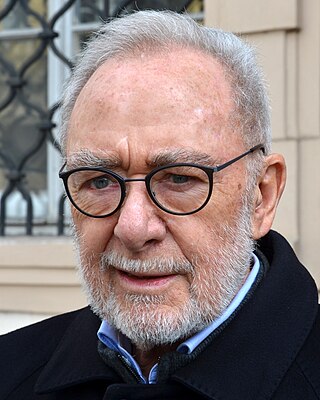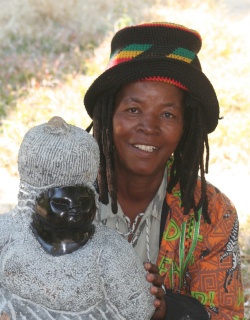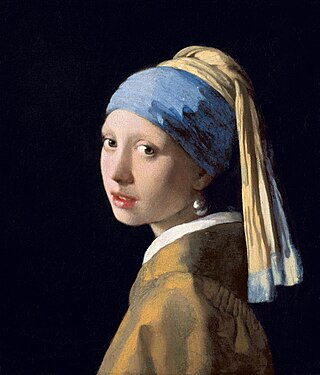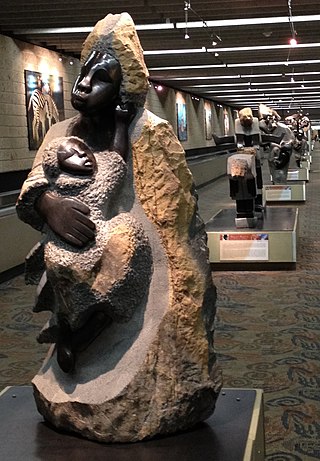
Modernism was an early 20th-century movement in literature, visual arts, and music that emphasized experimentation, abstraction, and subjective experience. Philosophy, politics, architecture, and social issues were all aspects of this movement. Modernism centered around beliefs in a "growing alienation" from prevailing "morality, optimism, and convention" and a desire to change how "human beings in a society interact and live together".
Abstract expressionism in the United States emerged as a distinct art movement in the immediate aftermath of World War II and gained mainstream acceptance in the 1950s, a shift from the American social realism of the 1930s influenced by the Great Depression and Mexican muralists. The term was first applied to American art in 1946 by the art critic Robert Coates. Key figures in the New York School, which was the center of this movement, included such artists as Arshile Gorky, Jackson Pollock, Franz Kline, Mark Rothko, Norman Lewis, Willem de Kooning, Adolph Gottlieb, Clyfford Still, Robert Motherwell and Theodoros Stamos among others.

Frank Philip Stella was an American painter, sculptor, and printmaker, noted for his work in the areas of minimalism and post-painterly abstraction. He lived and worked in New York City for much of his career before moving his studio to Rock Tavern, New York. Stella's work catalyzed the minimalist movement in the late 1950s. He moved to New York City in the late 1950s, where he created works which emphasized the picture-as-object. These were influenced by the abstract expressionist work of artists like Franz Kline and Jackson Pollock. He developed a reductionist approach to his art, saying he wanted to demonstrate that for him, every painting is "a flat surface with paint on it—nothing more", and disavowed conceptions of art as a means of expressing emotion. He won notice in the New York art world in 1959 when his four black pinstripe paintings were shown at the Museum of Modern Art. Stella was a recipient of the National Medal of Arts in 2009 and the Lifetime Achievement Award in Contemporary Sculpture by the International Sculpture Center in 2011.

Abstract art uses visual language of shape, form, color and line to create a composition which may exist with a degree of independence from visual references in the world.

Franz Kline was an American painter. He is associated with the Abstract Expressionist movement of the 1940s and 1950s. Kline, along with other action painters like Jackson Pollock, Willem de Kooning, Robert Motherwell, John Ferren, and Lee Krasner, as well as local poets, dancers, and musicians came to be known as the informal group, the New York School. Although he explored the same innovations to painting as the other artists in this group, Kline's work is distinct in itself and has been revered since the 1950s.

Gerhard Richter is a German visual artist. Richter has produced abstract as well as photorealistic paintings, and also photographs and glass pieces. He is widely regarded as one of the most important contemporary German artists and several of his works have set record prices at auction, with him being the most expensive living painter at one time.

Color field painting is a style of abstract painting that emerged in New York City during the 1940s and 1950s. It was inspired by European modernism and closely related to abstract expressionism, while many of its notable early proponents were among the pioneering abstract expressionists. Color field is characterized primarily by large fields of flat, solid color spread across or stained into the canvas creating areas of unbroken surface and a flat picture plane. The movement places less emphasis on gesture, brushstrokes and action in favor of an overall consistency of form and process. In color field painting "color is freed from objective context and becomes the subject in itself."

Orphism or Orphic Cubism, a term coined by the French poet Guillaume Apollinaire in 1912, was an offshoot of Cubism that focused on pure abstraction and bright colors, influenced by Fauvism, the theoretical writings of Paul Signac, Charles Henry and the dye chemist Michel Eugène Chevreul. This movement, perceived as key in the transition from Cubism to Abstract art, was pioneered by František Kupka, Robert Delaunay and Sonia Delaunay, who relaunched the use of color during the monochromatic phase of Cubism. The meaning of the term Orphism was elusive when it first appeared and remains to some extent vague.

Edwin Parker "Cy" Twombly Jr. was an American painter, sculptor and photographer.

Asemic writing is a wordless open semantic form of writing. The word asemic means "having no specific semantic content", or "without the smallest unit of meaning". With the non-specificity of asemic writing there comes a vacuum of meaning, which is left for the reader to fill in and interpret. All of this is similar to the way one would deduce meaning from an abstract work of art. Where asemic writing distinguishes itself among traditions of abstract art is in the asemic author's use of gestural constraint, and the retention of physical characteristics of writing such as lines and symbols. Asemic writing is a hybrid art form that fuses text and image into a unity, and then sets it free to arbitrary subjective interpretations. It may be compared to free writing or writing for its own sake, instead of writing to produce verbal context. The open nature of asemic works allows for meaning to occur across linguistic understanding; an asemic text may be "read" in a similar fashion regardless of the reader's natural language. Multiple meanings for the same symbolism are another possibility for an asemic work, that is, asemic writing can be polysemantic or have zero meaning, infinite meanings, or its meaning can evolve over time. Asemic works leave for the reader to decide how to translate and explore an asemic text; in this sense, the reader becomes co-creator of the asemic work.

Colleen Madamombe (1964–2009) was a Zimbabwean sculptor working primarily in stone. Her work expresses themes of womanhood, motherhood, and tribal Matriarchy.
Godfrey Kennedy is a Zimbabwean sculptor.
Wire sculpture is the creation of sculpture or jewelry out of wire. The use of metal wire in jewelry dates back to the 2nd Dynasty in Egypt and to the Bronze and Iron Ages in Europe. In the 20th century, the works of Alexander Calder, Ruth Asawa, and other modern practitioners developed the medium of wire sculpture as an art form.

The history of Western painting represents a continuous, though disrupted, tradition from antiquity until the present time. Until the mid-19th century it was primarily concerned with representational and traditional modes of production, after which time more modern, abstract and conceptual forms gained favor.

Painting is a visual art, which is characterized by the practice of applying paint, pigment, color or other medium to a solid surface. The medium is commonly applied to the base with a brush, but other implements, such as knives, sponges, and airbrushes, may be used.

Sculpture and in particular stone sculpture is an art for which Zimbabwe is well known around the world.
Martin Eichinger is an American sculptor. Deemed one of the few 'Living Masters' by the Art Renewal Center, Eichinger is known for his bronze narrative sculptures that, as he puts it, "chronicle the eternal human pursuit of meaning, happiness, and growth." Eichinger has been sculpting for over 40 years and is represented by many elite galleries across the country. He currently lives in Portland, Oregon and is an active and influential figure in the Northwestern sculpting community.
Blind artists are people who are physically unable to see normally, yet work in the visual arts. This seeming contradiction is overcome when one understands that only around 10% of all people with blindness can see absolutely nothing at all. As such most blind people can in fact perceive some level of light and form, and it is by applying this limited vision that many blind artists create intelligible art. Also, a blind person may once have been fully sighted and yet simply lost part of their vision through injury or illness. Blind artists are able to offer insight into the study of blindness and the ways in which art can be perceived by the blind, in order to better improve art education for the visually impaired.

Light and Space denotes a loosely affiliated art movement related to op art, minimalism and geometric abstraction originating in Southern California in the 1960s and influenced by John McLaughlin. It is characterized by a focus on perceptual phenomena, such as light, volume and scale, and the use of materials such as glass, neon, fluorescent lights, resin and cast acrylic, often forming installations conditioned by the work's surroundings. Whether by directing the flow of natural light, embedding artificial light within objects or architecture, or by playing with light through the use of transparent, translucent or reflective materials, Light and Space artists make the spectator's experience of light and other sensory phenomena under specific conditions the focus of their work. From the movement's inception, artists were incorporating into their work the latest technologies of the Southern California-based engineering and aerospace industries to develop sensuous, light-filled objects. Turrell, who has spread the movement worldwide, summed up its philosophy in saying, "We eat light, drink it in through our skins."
Celia Winter-Irving, was an Australian-born, Zimbabwean-based artist and art critic who wrote extensively on Zimbabwean art, especially Shona sculpture, when she lived in Harare from 1987 to 2008.













